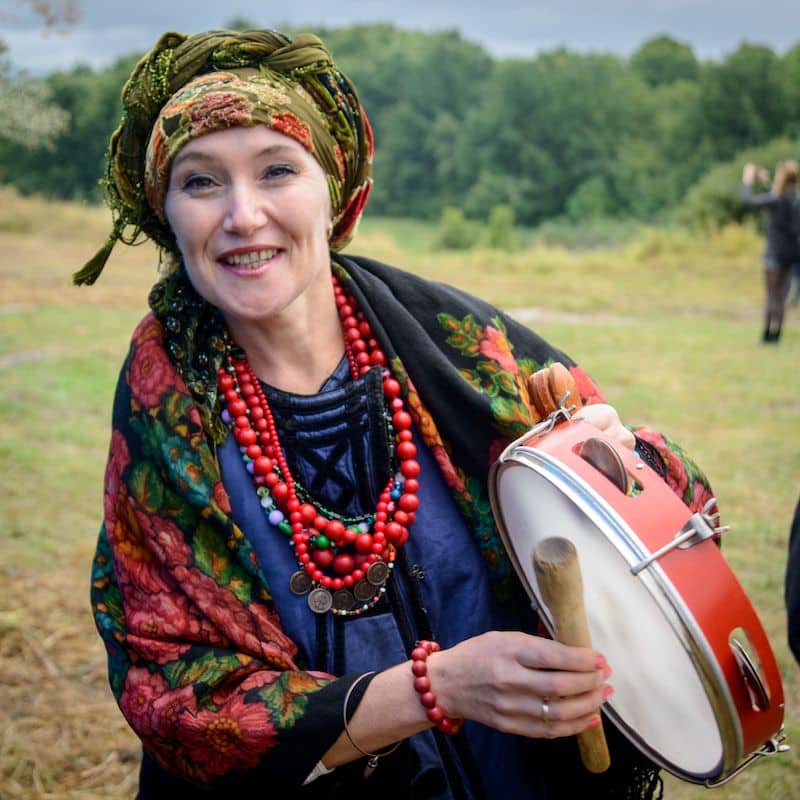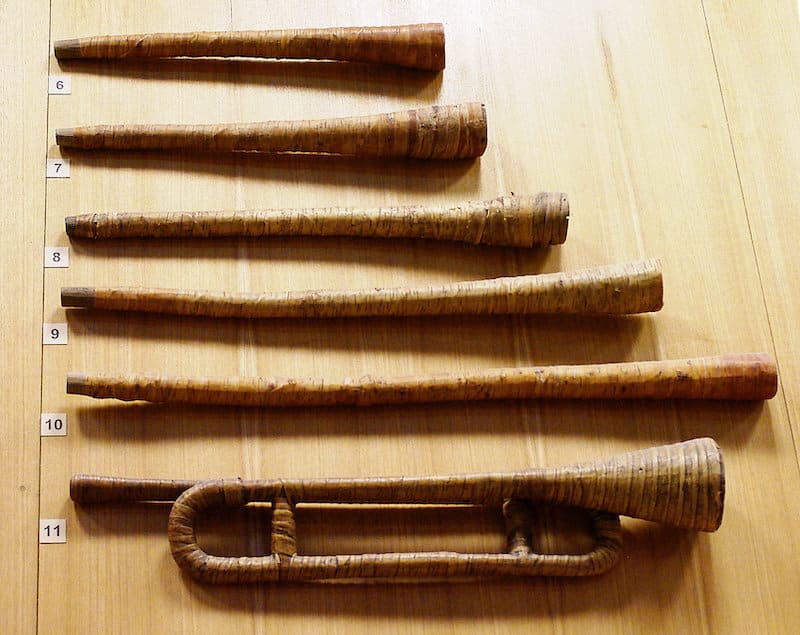Russian folk music began early in the 11th century, primarily as vocal-centric music with no instruments. Since these early days, Russian music instruments have been through a fairly tough journey. Music instruments were actually prohibited for many years, but that didn’t stop Russian folk music from developing and its popularity from spreading.
The first Russian musical instruments were simple. However, over time, more sophisticated instruments were introduced. Let’s take a look at 15 traditional Russian musical instruments that are used in Russian folk music!
1. Domra
The Domra is a string instrument that belongs to the lute family. It’s found in several cultures, like Russian, Ukrainian, and Belarusian music.
The domra’s history begins in 1896 when one of the students of Vasily Vasilievich Andreyev found a string instrument that was broken in a stable.
The instrument landed in the hands of Andreyev, who developed it to be the instrument we know today.
The domra is famous for its round body and a long neck with 3-4 metal strings. However, Russia is famous for the three-stringed version.
When played in a balalaika orchestra, domra plays the lead melody. It’s held like a guitar and can be either played with a pick or fingers. Tamara Volskaya is a well-known player of the domra.
2. Balalaika
The Balalaika is another type of lute very similar to the domra. Some even say that it descended from the Domra. But they are very different to look at and the balalaika had a distinctive triangular body
The history of the balalaika dates back to the 17th century when a group of people called “Skomorokhi” performed around Russia using domras and balalaikas. Ordinary people loved those performers, but the church and the authorities hated them.
So, Tsar Alexei Mikhailovich ordered the burning of all the instruments used by the “Skomorokhi” and to punish whoever uses them. Balalaika didn’t achieve its popularity until Andreyev passed by a peasant plating it.
Andreyev learned how to play it and sought the help of a violin maker to develop this amazing instrument. And that’s why Vasily Andreyev earned the nickname “father of the balalaika.”
3. Accordion
In Russia, the Accordion can refer to three different instruments: Garmoshka, Bayan, and the traditional Accordion.
The accordion came originally from Europe and made its way to Russia to eventually become a Russian national instrument and the soul of folk music.
Timofey Vorontsov was the first accordion inventor in Tule in 1820, followed by Ivan Sizov in 1830. By the late 19th century, Russia was manufacturing more than 700,000 accordions per year.
Although there are lots of types of accordion, the chromatic accordion is the most popular in Russia with many composers writing pieces for solo accordions as well as in ensembles.
4. Treshchotka
The Treshchotka is a type of Russian percussion instrument that means “rattle.” This unusual looking instrument makes the sound of cracking and hand clapping.
It’s made of a set of 10 to 30 thin oak slats that are threaded together by a tough string. To play the treshchotka, hold it by the end of the strings, stretch it like an accordion, and then squeeze the slats together.
To produce different rhythms, volumes, and sounds, the musician can use different levels of force as well as varying the slats’ angle to produce different sounds.
Fun fact: it’s a Russian tradition to play the treshchotka at weddings to ward off evil spirits from the bride and groom.
5. Gusli
The Gusli is known to be the oldest East Slavic multi-string instrument. It belongs to the zither family as the strings are placed horizontally on the body.
It’s played by plucking with either your fingers or a mediator depending on its size.
The sound produced by a gusli is so comforting and calming and was often used as an accompanyment to telling fairy tales.
There are several types of gusli instruments with different body shapes and numbers of strings. The most popular are the Krylovidnye gusli with a wing-shaped body with 4 to 14 strings, the Shlemovidnye gusli with a helmet-shaped body, and 11 to 36 strings.
Lastly, is the rectangular desk-top gusli, with its 55-66 strings.
In 1914, N. P. Fomin created another version of the gusli that uses a keyboard. With this type, the performer plays with his left hand on the keys and plucks the strings with his right hand.
6. Zhaleika
A Zhaleika, which is also known as the “Russian folk clarinet,” is one of the most popular Russian wind instruments.
Its design consists of a wooden pipe of 10 to 20 cm (3.9 to 7.8 inches) long with between 3 and 7 finger holes to produce different pitches.
It also has a single-reed that is made of cane or goose feather, and the end bell is either made of cow horn or birch bark.
It was used in the past by shepherds to collect animals because the sound of zhaleika can be heard from a distance of up to 6 km.
7. Lozhki
The Lozhki is another type of Russian percussion instrument that consists of two wooden spoons. Yes, you read that right!
Since ancient times, the Eastern Slavic used percussion instruments in war and hunting rituals, as well as in singing and dancing, and lozhki has been a part of these rituals.
In the 19th century, spoons were used in choirs and folk music orchestras. Those musical spoons are made of wood that is harder than what regular spoons are made of. They also usually have longer handles and the ladle has a polished surface.
There are various techniques to playing the lozhki. Lozhki players can play a set of two, three, or even four spoons to produce different pitches. They can perform solo, accompanied by singing and dancing, or played with other instruments.
8. Buben

A Buben is yet another Russian percussion instrument that’s also known by the name “Russian tambourine.”
It’s a handheld instrument that consists of a narrow round frame with a membrane that’s made of either rawhide or man-made materials.
The membrane is stretched on the outside of the frame. Usually, the frame of a Buben has little bells or pairs of jingles in its slots.
Skomorokhi (medieval jesters of sort), and bear tamers would often use Buben in their performances.
Folk virtuoso Buben players do all sorts of tricks, such as banging it on their knees, head, and feet, tossing it up in the air and catching it, and of course beating it up with hands, fingers, and elbows.
9. Volynka
Volynka, or Volinka, is the name given by Russians to their version of the bagpipes. The bagpipes aren’t originally a Russian instrument, but it has its part in Russian folk music.
The bagpipes became a part of Russian instruments in the late 18th century when Matthew Guthrie, an antiquarian, saw the Finns living in Russia playing this instrument.
The traditional bagpipe was made of undressed goatskin which of course made the instrument not pleasantly smelling.
Later on, every Russian village started making its own volynka. They made the bag out of goat, pig, or sheep stomach.
The volynka has a chanter with finger holes and there’s a reed in the mouthpiece. The volynka has either one or two drone pipes.
10. Bayan
The Bayan was created in the early 20th century and ever since it became a stable Russian folk music instrument.
It’s a type of chromatic button accordion. However, the bayan has its unique sounds. It sounds different from western accordions and produces a much fuller bass sound.
Although the instrument was made to fulfill the requirement of folk music, it’s used to compose classical music. Vladislav Zolotaryov and Sofia Gubaidulina are both famous musicians who composed several music pieces that include the bayan.
11. Rozhok
TheRozhok is another ancient Russian wind instrument that’s history is thought to date back to the 17th century.
The rozhok takes the shape of a straight conical pipe with one thumb hole, five finger holes, and a mouthpiece that is cut taking the shape of a small cup.
It’s easy to differentiate this instrument with its conical bell-shaped end. The tube is made from birch, maple, or juniper with juniper rozhok producing the best sound characteristics.
Rozhok has several names, such as Shepherd’s rozhok and Russian rozhok. However, in the late 19th century, it became famous for the name “Vladimirskiy rozhok.” This was due to the success of a rozhok choir that came from the Vladimir region.
His choir members were all simple shepherds with no prior classical music education.
12. Gudok
The Gudok is another ancient Russian string instrument that was a favorite of the Skomorokhi.
That instrument is characterized by its pear-shaped wooden body, short fretless fingerboard, and three strings. It’s played with a bow and is held on the musician’s lap or knees like a cello or a viola.
Although the gudok was popular in Russia for a long time, and it even survived Aleksey Mikhaylovich’s time as a Tsar, it couldn’t survive the domination of western music.
Unfortunately, gudok disappeared for several centuries from Russian culture and was replaced by the violin. Some efforts are being made by folk music groups to bring it back to life and hopefully, they’ll succeed.
13. Garmoshka
Garmoshka, or the Russian Garmon, is another traditional reed instrument like the bayan and the accordion.
The garmoshka has bellows and two-button keyboards on both sides. The buttons of the right side keyboard play the notes of the diatonic scale while the buttons on the left side keyboard play the primary chords along with the bass notes.
The garmon appeared in Russia in the 18th century. It’s smaller in size than the bayan and the accordion and produces a higher sound.
Folk ditties and couplets performers love to use the garmon in their performances. The garmoshka along with the bayan and accordion was used to raise the fighting spirits of the soldiers during World War II.
Fun fact: those who can play the garmoshka are considered the most popular in their village.
14. Svirel
The Svirel is an old wind instrument that’s quite popular in Russian folk music.
It’s thought that Lel, the son of Lada, the Slavic goddess, played the svirel. He would make his svirel using birch branches in the spring.
This wind instrument is a wooden pipe and sometimes metal. It consists of six finger holes and a whistle device that looks like a beak on its upper end. The preferred wood for making svirel is hazel, maple, ash tree, and buckthorn.
You can still find modern folk orchestras using the svirel in their music.
15. Kalyuka
By now, we know that Russia has various wind instruments, and the Kalyuka is one of them.
Kalyuka is a traditional Russian folk music instrument that is similar to the overtone flute. It’s a hollow tube with no tone holes along its body like modern flutes.
Traditionally, kalyuka were made from dried hollow umbellate plant stalks which made the instrument fragile and used for only one season. Nowadays, kalyuka is made from PVC for more durability.
The length of a kalyuka ranges from 30 cm to 80 cm which depends on the player’s height.
Traditionally, kalyukas were used by peasants after haymaking.
Summing up our List of Russian Instruments
To this day, Russian folk music is still going strong and thriving with its unique instruments, even in the presence of popular western music.
We recommend looking up each of the above-listed instruments on YouTube to get a glimpse of how unique and mesmerizing they sound.


